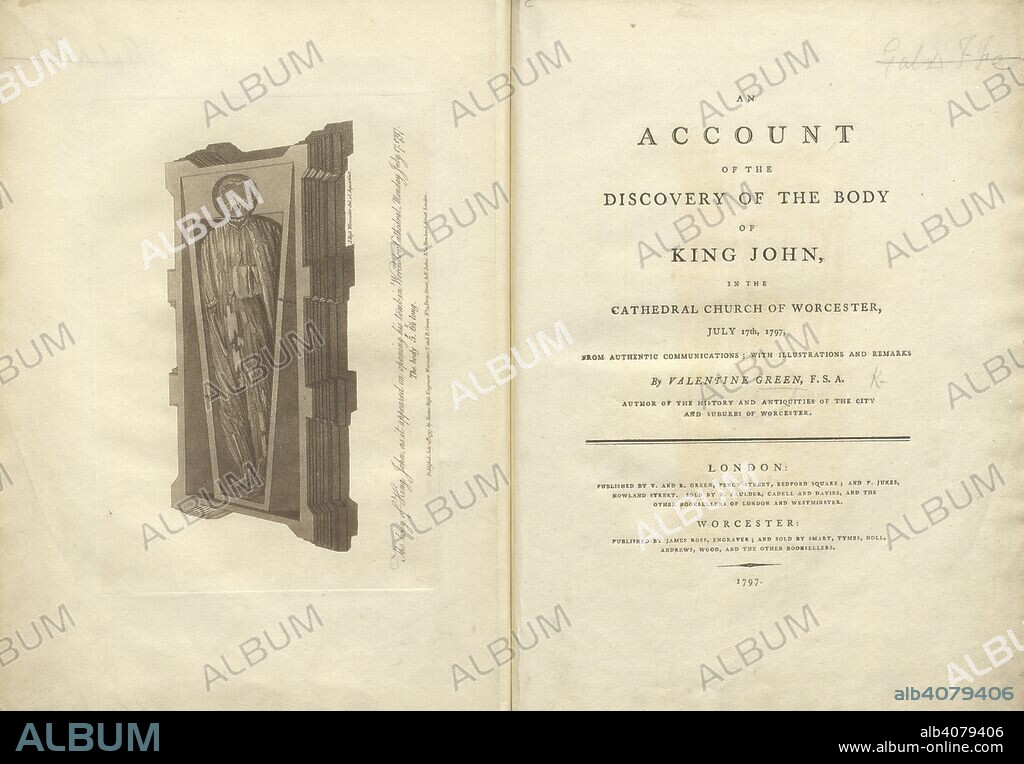alb4079406
In 1797 the tomb of King John at Worcester Cathedral was opened at the prompting of the engraver Valentine Green (d. 1813). Green had written a history of the city of Worcester, and had come to doubt previous descriptions of the tomb and its contents, among which was a longstanding contention that John had been buried elsewhere within the church. The effigy was removed first, followed by the slab on which it rested; inside the tomb chest, a stone coffin was discovered, containing the royal remains. The Dean and Chapter of Worcester Cathedral were immediately summoned, and inspection made of the King’s body. Green describes how thousands thronged to see King John before the tomb was restored the next day and the coffin closed to sight. Opposite the title page of Green’s account is this engraving, inscribed, ‘The body of King John, as it appeared on opening his tomb in Worcester Cathedral, Monday July 17 1797’. An account of the discovery of the body of King John in the Cathedral Church of Worcester, July 17, 1797, etc. London ; Worcester, 1797. Source: 814.l.23, frontispiece and title page. Language: English.

|
Add to another lightbox |
|
Add to another lightbox |



Caption:
In 1797 the tomb of King John at Worcester Cathedral was opened at the prompting of the engraver Valentine Green (d. 1813). Green had written a history of the city of Worcester, and had come to doubt previous descriptions of the tomb and its contents, among which was a longstanding contention that John had been buried elsewhere within the church. The effigy was removed first, followed by the slab on which it rested; inside the tomb chest, a stone coffin was discovered, containing the royal remains. The Dean and Chapter of Worcester Cathedral were immediately summoned, and inspection made of the King’s body. Green describes how thousands thronged to see King John before the tomb was restored the next day and the coffin closed to sight. Opposite the title page of Green’s account is this engraving, inscribed, ‘The body of King John, as it appeared on opening his tomb in Worcester Cathedral, Monday July 17 1797’. An account of the discovery of the body of King John in the Cathedral Church of Worcester, July 17, 1797, etc. London ; Worcester, 1797. Source: 814.l.23, frontispiece and title page. Language: English.
Credit:
Album / British Library
Releases:
Model: No - Property: No
Rights questions?
Rights questions?
Image size:
5004 x 3476 px | 49.8 MB
Print size:
42.4 x 29.4 cm | 16.7 x 11.6 in (300 dpi)
Keywords:
18TH CENTURY • 18TH CENTURY, THE • 18TH • ARCHIVE • ARCHIVES • BOOK • BRITISH LIBRARY EXHIBITION • BRITISH LIBRARY EXHIBITIONS • DEAD • DEATH • DECEASED • DOCUMENT • EVENT • EVENTS • FREEDOM • FRONTISPIECE • FUNERARY • GRAVE • JOHN 1 • JOHN I • JOHN • KING JOHN OF ENGLAND • KING JOHN • LACKLAND • LEGACY • LIBERTY • LIBRO • MAGNA CARTA ANNIVERSARY • MAGNA CARTA EXHIBITION • MAGNA CARTA: LAW • SEPULCHER • SÉPULCRE • TEXT • TITLE PAGE • TOMB • TOMBS • WRITTEN LANGUAGE
 Pinterest
Pinterest Twitter
Twitter Facebook
Facebook Copy link
Copy link Email
Email

